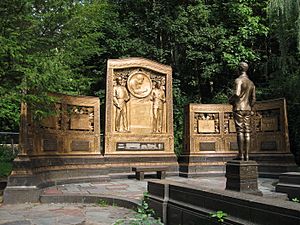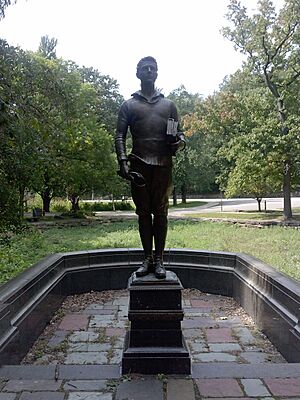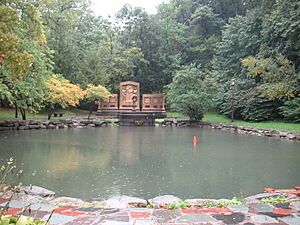Westinghouse Memorial facts for kids
 |
|
| Coordinates | 40°26′22″N 79°56′34″W / 40.43946°N 79.94271°W |
|---|---|
| Location | Schenley Park, Pittsburgh, Pennsylvania |
| Material | Bronze, Norwegian granite |
| Opening date | 6 October 1930 |
| Dedicated to | George Westinghouse |
The Westinghouse Memorial is a special bronze monument in Pittsburgh, Pennsylvania. It honors George Westinghouse, a brilliant engineer and the inventor of the railway air brake. You can find this memorial at the entrance to the Steven Faloon trail, which is part of Schenley Park.
The memorial was designed by architects Henry Hornbostel and Eric Fisher Wood. The main statue and central panel were created by Daniel Chester French. Paul Fjelde designed the panels on the sides.
At the memorial, you'll see a statue of a schoolboy. This boy represents "The Spirit of the American Youth." He looks at three panels that show important moments from George Westinghouse's life. The idea is that the boy finds inspiration from these stories. The memorial is made from strong bronze and granite. There are many other tributes to George Westinghouse in the area, like Westinghouse Park and the George Westinghouse Memorial Bridge.
The memorial is located near Carnegie Mellon University in the Squirrel Hill neighborhood of Pittsburgh. Schenley Drive, a road that goes through the park, is also very close by.
Contents
Why Was the Westinghouse Memorial Built?
The idea for a memorial to George Westinghouse first came up in 1916. This was two years after he passed away. The Pittsburgh City Council suggested building it. At first, they thought about putting it at Westinghouse's old home, Solitude. This spot is now Westinghouse Park.
However, in 1926, the City Council decided to build the memorial in Schenley Park instead. The Westinghouse Memorial Association managed the project. It took four years to plan and build.
Who Designed the Memorial?
Pittsburgh architects Henry Hornbostel and Eric Fisher Wood were chosen to design the memorial. Famous sculptor Daniel Chester French created the main statue and figures. French is well-known for his statue of Abraham Lincoln at the Lincoln Memorial. Paul Fjelde made the other sculptures. The bronze parts were made by the Gorham Manufacturing Company in Rhode Island. Masaniello Piccirilli, one of the Piccirilli Brothers, spent about 14 months making the wax models for the bronze pieces.
How Was the Memorial Funded?
More than 50,000 Westinghouse employees helped pay for the memorial. They raised a total of $200,000. That was a lot of money back then!
The memorial was officially opened on October 6, 1930. This was George Westinghouse's birthday. Pittsburgh mayor Charles H. Kline even called it "Westinghouse Day." All local Westinghouse employees got the day off work. About 12,000 people came to the ceremony. Many important leaders and inventors attended, including B. C. Forbes and James J. Davis. Even Thomas Edison, Westinghouse's old rival, sent a message.
What Happened to the Memorial Over Time?
When it was first built, the bronze memorial was covered in gold leaf. This was meant to make it look interesting and stand out in the city's smoky air. But people could easily scratch off the gold with a knife. Sadly, the memorial was often vandalized with names and drawings.
In 1937, the city spent $4,000 to fix it. But just four years later, it was damaged again. So, they decided to remove all the gold leaf. The Westinghouse Air Brake Company paid for this, and it was finished in December 1941.
The memorial was repaired again in 1984. The American Youth sculpture had been knocked over by vandals. It was removed for safety and then fixed.
By 2014, the memorial needed more work. The lily pond stopped holding water in 2009. Winter weather and vandals had also damaged the monument. In 2015, a big restoration project began. The Pittsburgh Parks Conservancy and the City of Pittsburgh worked together. This project cost $2.7 million and took 14 months. They rebuilt the pond, replaced pathways, planted new trees, and improved water drainage. The memorial was rededicated on October 6, 2016.
What Does the Westinghouse Memorial Look Like?
The memorial has three bronze panels that show George Westinghouse's life. A statue of a school-aged boy faces these panels. The area around it includes a lily pond, stone paths, and black granite benches. The design of the memorial shows a strong Beaux-Arts style. This style was popular in France. It also includes modern touches, like showing everyday people instead of old Greek or Roman figures.
The Bronze Panels
The three panels are arranged in a half-circle. They sit on a base made of Norwegian granite. Each panel is solid bronze.
- Central Panel: This panel shows George Westinghouse at his drafting table. It also has figures of a mechanic and an engineer. There's text and a granite plaque remembering the first test of the Westinghouse air brake. The models for the workers were actual Westinghouse employees.
- Side Panels: These panels show Westinghouse's engineering achievements. This includes the electrification of the New York, New Haven, and Hartford Railroad, the electrical system at the World's Columbian Exposition, and the Adams Power Plant at Niagara Falls. Each image is supported by two sculpted turtles.
What's cool is that some parts of the sculptures continue on the back of the memorial. For example, oak leaves seen through the panels become full trees when viewed from behind. The back of the mechanic and engineer figures are also fully sculpted.
The back of the memorial also has a special dedication plaque. It says:
This memorial unveiled October 6, 1930, in honor of George Westinghouse is an enduring testimonial to the esteem, affection and loyalty of 60,000 employees of the great industrial organizations of which he was the founder. In his later years rightly called "The Greatest Living Engineer", George Westinghouse accomplished much of first importance to mankind through his ingenuity, persistence, courage, integrity and leadership. By the invention of the air brake and of automatic signaling devices, he led the world in the development of appliances for the promotion of speed, safety and economy of transportation. By his early vision of the value the alternating current electric system, he brought about a revolution in the transmission of electric power. His achievements were great, his energy and enthusiasm boundless, and his character beyond reproach; a shining mark for the guidance and encouragement of American youth.
The Spirit of the American Youth Statue
Facing the panels is a life-size bronze statue by Daniel Chester French. It's called The Spirit of the American Youth. The statue shows a school-aged boy holding books and a hat. He looks like he's thinking about George Westinghouse's life and achievements. The statue stands on a granite base that looks like the front of a ship. It sticks out into the lily pond. Sometimes, the statue has been spray-painted by vandals.
The Lily Pond and Gardens
The lily pond, paved walkways, and plants are a big part of the memorial's design. Some parts, like the pond, were there before the memorial was built. Others were added later. Even though things have changed, the memorial still looks much like its original design.
The lily pond was built in 1896. It used to get water from a stream called Phipps Run. But the pond got damaged by storms. So, it now uses city water, and Phipps Run goes underground. The pond got worse and had to be emptied in 2009. It was rebuilt and refilled during the 2015–16 restoration.
Many trees, shrubs, and flowers are planted around the memorial. In 1931, forty cherry trees were given as a gift from the Westinghouse Society of Japan. In 1965, another 12 trees were donated by Mitsubishi Electric Corporation.



